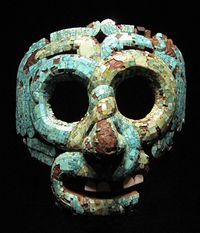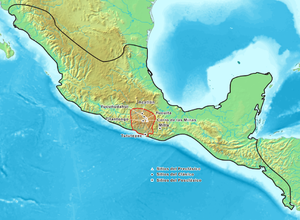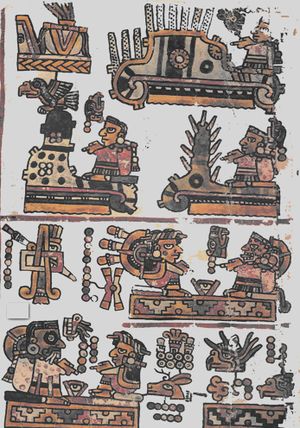ميستك
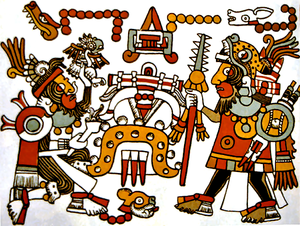 ملك الميستك وأمير الحرب Eight Deer Jaguar Claw (right) Meeting with Four Jaguar, in a depiction from the pre-Columbian Codex Zouche-Nuttall. | |
| إجمالي التعداد | |
|---|---|
| Approximately 830,000[1][2] | |
| المناطق ذات التجمعات المعتبرة | |
| Mexico ( | |
| اللغات | |
| Mixtec, Spanish | |
| الدين | |
| Roman Catholicism with elements of traditional beliefs | |
| الجماعات العرقية ذات الصلة | |
| Zapotecs, Trique |
ميستك (Mixtec ؛ /ˈmiːstɛk/ أو /ˈmiːʃtɛk/[3] أو Mixtecos، هم شعوب ميزو أمريكية في المكسيك تعيش في منطقة تُعرف بإسم لا ميشتكا La Mixteca في واخاكا و پوِبلا وكذلك في منطقة مونتانياس بولاية گريرو، و منطقة كوستا تشيكا، التي تغطي أجزاء من الولايات المكسيكية واخاكا، و گريرو و پوِبلا.
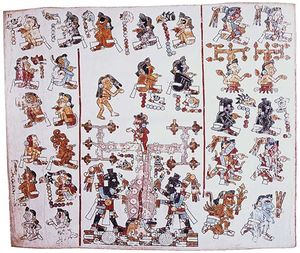
The Mixtec region and the Mixtec peoples are traditionally divided into three groups, two based on their original economic caste and one based on the region they settled. High Mixtecs or mixteco alto were of the upper class and generally richer; the Low Mixtecs or "mixteco bajo" were generally poorer. In recent times, an economic reversal or equalizing has been seen. The third group is Coastal Mixtecs "mixteco de la costa" whose language is closely related to that of the Low Mixtecs; they currently inhabit the Pacific slope of Oaxaca and Guerrero. The Mixtec languages form a major branch of the Otomanguean language family.
In pre-Columbian times, a number of Mixtecan city states competed with each other and with the Zapotec kingdoms. The major Mixtec polity was Tututepec which rose to prominence in the 11th century under the leadership of Eight Deer Jaguar Claw, the only Mixtec king who ever united the Highland and Lowland polities into a single state. Like the rest of the indigenous peoples of Mexico, the Mixtec were conquered by the Spanish invaders and their indigenous allies in the 16th century. Pre-Columbia Mixtecs numbered around 1.5 million.[4] Today there are approximately 800,000 Mixtec people in Mexico, and there are also large populations in the United States.
الاسم
The term Mixtec (Mixteco in Spanish) comes from the Nahuatl word mixtecah [miʃˈtekaʔ], "cloud people" . There are many names that the Mixtecs have for naming themselves: ñuù savi, nayívi savi, ñuù davi, nayivi davi.[النُطق؟] etc. This all denominations can be translated as 'people of the rain'. The historic homeland of Mixtec people is La Mixteca, called in Mixtec language Ñuu Savi[النُطق؟], Ñuu Djau[النُطق؟], Ñuu Davi[النُطق؟], etc., depending on the local variant. They call their language sa'an davi[النُطق؟], da'an davi[النُطق؟] or tu'un savi[النُطق؟].
الجغرافيا
اللغة ومجموعات المخطوطات والأعمال الفنية
The Mixtecan languages (in their many variants) were estimated to be spoken by about 300,000 people at the end of the 20th century, although the majority of Mixtec speakers also had at least a working knowledge of the Spanish language. Some Mixtecan languages are called by names other than Mixtec, particularly Cuicatec (Cuicateco), and Triqui (or Trique).
الهامش
- ^ Comisión Nacional para el Desarrollo de los Pueblos Indios (CDI) (2000): Lenguas indígenas de México. Viewed 2006-11-30.
- ^ Instituto de los Mexicanos en el Exterior: Lazos. Síntesis informativa, 2005-1-24. Viewed 2006-11-30
- ^ قالب:OED
- ^ archaeology.about.com › ... › Archaeology 101 › Glossary › M Terms
للاستزادة
- Kevin Terraciano (2004). The Mixtecs of Colonial Oaxaca: Nudzahui History, Sixteenth Through Eighteenth Centuries. Stanford University Press. ISBN 978-0804751049.
وصلات خارجية
قالب:Indigenous peoples of Mexico
قالب:Indigenous people of Oaxaca
